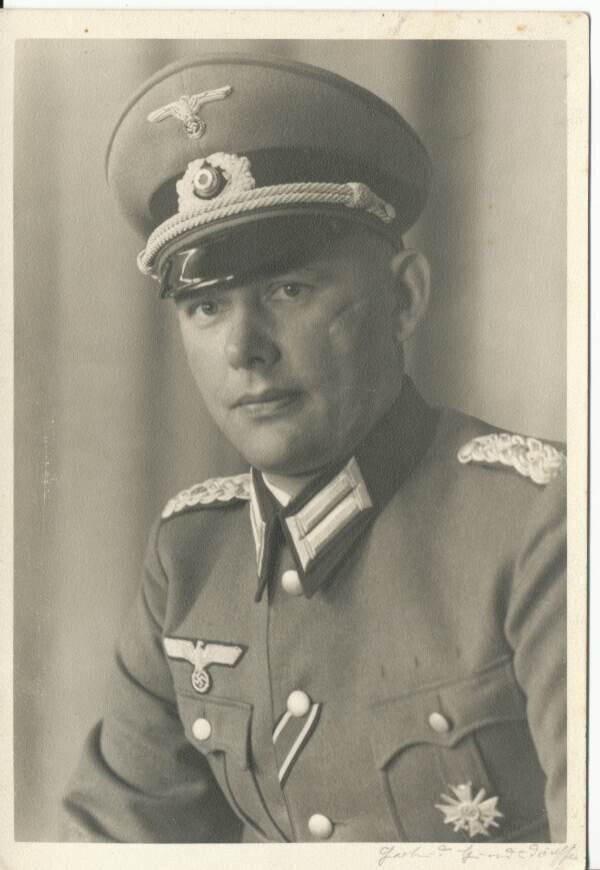Apologies for not posting any interesting original material in the past few weeks, I’ve been busy dealing with the holidays and the celebrations that inevitably pop up at this time of year. Today’s blog post will be about a topic I’ve become fascinated with over the course of the past two years. Have you ever wondered why stereotypical WWI German media characters from WWI always seem to have a large scar on their face? Ever wonder why they always seem to be on the cheek and always are attributed with men of high status such as generals and higher ranking officers?
Well, recently I was able to purchase on eBay an inexpensive photo ($4.99) on eBay that perfectly personifies the image of a young WWI German soldier with a prominent facial scar.

Mensur Scar (New photo to collection)
Was this scar the result of a bad shaving accident? In fact, the answer is exactly the opposite; this left cheek scar is the result of a deliberate action.

Ouch!
After a solid night of internet research, I was able to cobble together an answer regarding the odd number of facial scars associated with late 19th and early 20th century German and Austrian soldiers. The Dueling Scar!
Male (upper class) students who were members of fraternities of major German and Austrian universities during this time were often engaged in academic fencing which at times would, at times, become a duel between competing fraternities. These individualized duels between students eventually became a badge of honor among fraternity members – taking a blow to the face showed courage and was a lasting reminder of the fraternal bond.
Since these boys were often from a higher class, it was no surprise that many eventually became officers during WWI. This act was well know during the time and eventually became banned around the time of the outbreak of the war. The ban was lifted when Adolf Hitler came to power in 1933. Many of the German officers of WWII had these scars given the fact that they were in university prior to WWI.
A fun fact – The majority of scars appear on the left side of the face due to the fact that many fencers were trained in a right-handed style!
Skip ahead to 2:50 to see the duel in action!

Otto Skorzeny with Mensur Scar

German Pilot Eduard Wolfgang Zorer




Cartoon View ca. 1909 (From eBay listing)

Luftwaffe Portrait Photo (from an eBay auction)






Burschenschaften still exist today – I was recently privy to witness a duel in a frat haus: very unusual as these groups can be fairly secretive. The people I have met in 12 years in Germany are conservative at the very least and sometimes fairly right-wing. A recent incident in Munich throws this into sharp relief – they wanted to refuse membership to a Chinese student – because he was Chinese. They claim that the banning of the groups under Hitler shows that they were a oppressed group -therefore suggestions that they are sympathetic to right-wing ideologies must be false. This overlooks the fact that they were not singled out for special treatment but rather their suppression was part of the wider policy of Gleichschaltung.
Taff,
Thanks for sharing! Hard to imagine that this still happens today, but then again, strange hazing rituals still happen at American universities.
Brennan
Just re-reading this and something has just come back to me: the two protagonists faced each other, perhaps a metre apart – and were unable to move, they had to attack and defend from were they stood – they could not advance or retreat a few steps as you do with normal sports fencing or HEMA. I’ve done both – in fact was doing HEMA just last night – and the urge to step out of a lunge from an opponent seems natural to me, step out or step in to disrupt their attack seems like common sense. Standing still takes some mental gymnastics
I actually had my stitches removed from my left ear that was severed after such a duel. I’m a student at an American University and we still fly the Nazi flag and hail to the great Adolph Hitler to this day.
Hahahahahahaha… nice try, commie.
Hahaha,
Such particular values and this “society” let you in with the surname/nachname ‘Frank’ ?!! You may have a relative with the forename ‘Anne’.
Odd and confused principles, and certainly not those of Mensur in Das Kaiserreich, when the formalities of the physical and honorific abilities were established, accepting of a broad spectrum of students.
A display here of the dangers of the dilution and corruption of traditional values, beyond its roots, for a dishonourable end. Not what my forebears duelled for.
Rod Stewart sings “the first cut is the deepest” & thank you sir. may I have another? natl. lampn.
Sometimes they made the scars WORSE on purpose, by embedding a horsehair in the wound and then ripping it out later. That would explain why the scarring was so very bad, too. My boyfriend was in a knife fight when he was young, and he got his upper lip slashed open to the teeth. He was upset at the time because he was a very, VERY pretty man and he thought that it would ruin his looks, but now there is absolutely no mark there to be seen.
I didn’t know that! good factoid!
Quite often the facial wounds were packed with horse hair prior to being stitched up. This helped promote the growth of thick, hard scar tissue in order to make the scar more prominent. I believe the ends of the hair were left outside of the stitch so that the hair could be pulled from the wound at a certain point during healing.